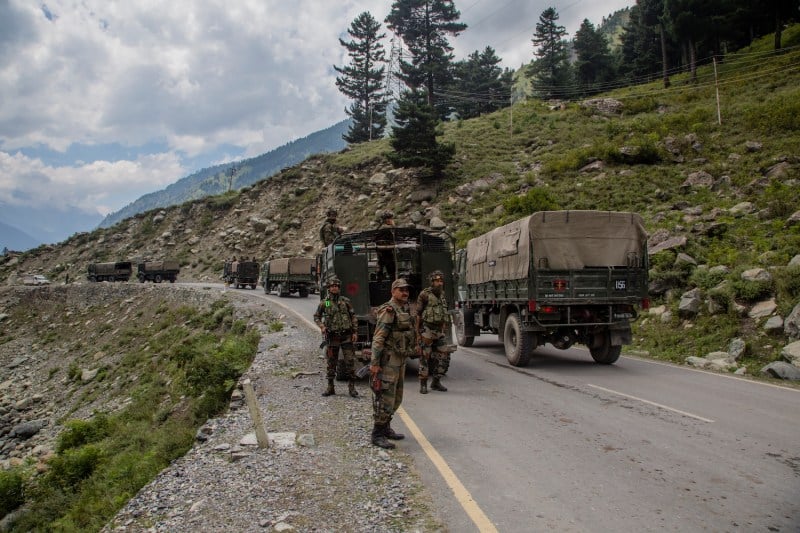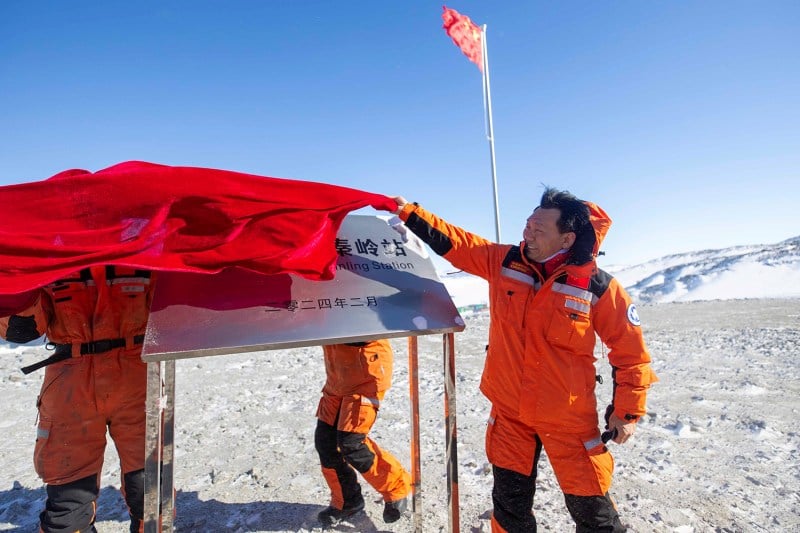Can India and China Turn the Corner?

Can India and China Turn the Corner?
Despite the recent thaw in tensions, the bilateral relationship is poised to remain tumultuous in 2025.
An Indian army convoy carrying reinforcements and supplies, is seen driving toward the town of Leh on a highway bordering China in Gagangir, India, on Sept. 2, 2020. Yawar Nazir/Getty Images
This year, India and China will mark the 75th anniversary of their diplomatic relationship, which is characterized by a mix of collaboration and disputes. Since the 1962 Sino-Indian war, New Delhi and Beijing have developed a sense of mistrust that has worsened in recent years.
In 2019, tensions deepened after India revoked the special autonomy of Jammu and Kashmir, including the Ladakh region, which borders China in the east; Beijing sharply objected. In 2020, military clashes along the countries’ disputed border in the Galwan Valley resulted in the deaths of more than 20 Indian and four Chinese soldiers. As border skirmishes continued that year, India responded by restricting Chinese investments; banning several Chinese mobile apps, including TikTok; and preventing the resumption of passenger flights to China following COVID-19 pandemic pauses.
This year, India and China will mark the 75th anniversary of their diplomatic relationship, which is characterized by a mix of collaboration and disputes. Since the 1962 Sino-Indian war, New Delhi and Beijing have developed a sense of mistrust that has worsened in recent years.
In 2019, tensions deepened after India revoked the special autonomy of Jammu and Kashmir, including the Ladakh region, which borders China in the east; Beijing sharply objected. In 2020, military clashes along the countries’ disputed border in the Galwan Valley resulted in the deaths of more than 20 Indian and four Chinese soldiers. As border skirmishes continued that year, India responded by restricting Chinese investments; banning several Chinese mobile apps, including TikTok; and preventing the resumption of passenger flights to China following COVID-19 pandemic pauses.
Nearly five years since the Galwan clash, India and China are seemingly open to reconciliation.
Last October, the Indian Army announced that it had successfully completed its disengagement with China in eastern Ladakh. At a bilateral meeting between Indian Prime Minister Narendra Modi and Chinese President Xi Jinping on the sidelines of the BRICS summit in Russia last October, both countries emphasized the importance of “mutual trust, mutual respect, and mutual sensitivity” and agreed to bolster communication and cooperation.
Despite the recent thaw, the India-China relationship is poised to remain tumultuous in 2025 due to their competing geopolitical interests and the shift in regional power dynamics.
Given the history of deep-seated mistrust and China’s assertive foreign policy, the question remains as to whether New Delhi can collaborate with Beijing—and what this evolving recalibration means for smaller countries in South Asia.
The oldest unresolved issue between India and China is their ongoing border dispute.
The two countries share a frontier of more than 2,000 miles, demarcated by the Line of Actual Control, which is the site of frequent skirmishes and incidents. The Doklam clash in 2017, the Galwan Valley clash in 2020, and continuing friction in the northeastern Indian states of Sikkim and Arunachal Pradesh have underscored the fragility of peace. Despite multiple rounds of talks last year, tensions have persisted. (Most recently, India voiced its concerns over China’s plan to build the world’s largest hydropower dam in Tibet.)
Meanwhile, both countries have constructed an extensive network of roads, railways, and airstrips to facilitate rapid troop mobilization near the border.
Since Modi came to power in 2014, India has strengthened its border infrastructure in Ladakh; boosted defense ties with European countries such as France, Germany, and Spain; and expanded its naval alliances in Southeast Asia. Though these measures have enhanced India’s deterrence capabilities, they have also fueled competition and increased China’s concerns about free passage in the ocean.
In recent years, India has also tilted toward the United States, strengthening its position within the Quadrilateral Security Dialogue, or the Quad, which also includes Australia and Japan. The group has pledged to keep China’s influence at bay and stop smaller countries from falling into Beijing’s “debt trap.” Though China views the Quad’s influence as a tool to perpetuate U.S. hegemony, it hasn’t stopped India from strengthening its position within the group.
India is increasingly prioritizing maritime security. It has expanded its naval capabilities and strengthened its defense ties with countries such as Japan and the United States to safeguard its strategic interests in the Indo-Pacific.
To counter China’s Belt and Road Initiative (BRI), India has also joined alternative infrastructure projects, such as the G-20’s Global Infrastructure Facility and the India-Middle East-Europe Economic Corridor.
However, India-China relations have begun to improve, driven by trade and potential Chinese investments in India’s key industries. In December, special representatives from both countries met to discuss how to maintain peace at the border and strengthen the bilateral relationship.
And at the end of January, the Indian foreign secretary visited Beijing and met with several Chinese officials. The two sides agreed to improve ties by resuming access to a holy Hindu site in Tibet, restoring direct flights between Beijing and New Delhi, issuing visas for journalists and think tank employees, and working toward sharing transborder river data.
However, the talks failed to address how the two countries will reduce investment and troops at the border, which remains heavily fortified.
The other issue that complicates the India-China relationship is the dilemma of achieving economic interdependence versus strategic decoupling. Despite their tense relationship, China overtook the United States in 2024 to once again become India’s largest trading partner, with India importing more than $100 billion worth of goods from China that year alone. Ahead of the December talks, a report from India’s chief economic advisor called for even more foreign direct investment from China.
Though India represents a crucial and large consumer market for China, a rise in anti-China sentiment driven by the border tensions in 2020 and 2021 has led to heightened scrutiny over Chinese investments. Since then, India has worked to reduce its reliance on Chinese goods, particularly in strategic sectors such as electronics and renewable energy, by boosting manufacturing and diversifying its supply chains. One such example is India’s telecommunications ministry leaving out Chinese equipment makers Huawei and ZTE from trials to set up the country’s 5G network in 2021.
While India’s efforts at decoupling are politically desirable, the reality is more complicated. India has sought to attract Taiwanese investment, especially in the semiconductor sector, but the scale of China’s economic influence and the gaps in India’s domestic capabilities mean that full decoupling remains a long-term challenge.
In 2025, India’s economic ties with China are likely to remain uneasy, despite recent diplomatic progress, as New Delhi’s growing closeness with the Trump administration has reshaped its strategic calculus.
Modi’s upcoming visit to the United States underscores this shift, with Washington’s rivalry with Beijing further complicating the situation.
By prioritizing the United States, India risks achieving limited returns while losing access to China’s economic and technological opportunities—highlighting the challenges of balancing competing partnerships in an increasingly polarized global order.
In addition to detangling their military and economic interests, India and China also need to address their competing geopolitical ambitions. China’s growing influence in South Asia is a significant challenge for India. The China-Pakistan Economic Corridor, which is part of the BRI, has become a cornerstone of relations between Beijing and Islamabad. Considering India’s territorial dispute with Pakistan over Kashmir, India has reiterated that it is against the corridor project, arguing that it goes against its “territorial integrity and sovereignty.”
In Sri Lanka, Hambantota Port—leased to a Chinese firm—has been a focal point of China’s strategic influence, leading to concerns in New Delhi about Beijing’s growing presence in its backyard. India has accused China of using the port to dock research vessels that are being used for spying purposes. Last month, Sri Lanka also signed an agreement with Sinopec, the Chinese energy giant, to fast-track a proposed $3.7 billion oil refinery in Hambantota.
In Nepal, which joined the BRI in December, Beijing has sought to invest in infrastructure as part of its broader strategy to integrate the Himalayan nation into its economic circle. For example, Beijing invested more than $200 million into the construction and opening of an international airport in Pokhara, Nepal. However, the project has threatened New Delhi, which is concerned about China potentially using the airport for military purposes. India has countered this strategy through offering development assistance, agricultural exports, increased purchases of hydropower, plans to build a dry port, and strengthening cultural exchanges with Nepal.
Similarly, Bangladesh has become a focal point for China’s growing regional influence since the fall of longtime Prime Minister Sheikh Hasina in August 2024. Last month, China verbally agreed to lower loan interest rates and extend repayment terms for Bangladesh under the BRI, signaling increased engagement with Dhaka’s interim government.
The situation in Myanmar, which borders both India and China, is another point of contention four years after the country’s military seized power in a coup. While China has engaged with both the ruling junta and rebel groups, offering weapons and mediation, India has maintained a noninterference policy in Myanmar. China’s deepening ties with Myanmar, including the China-Myanmar Economic Corridor, have expanded its influence in India’s backyard and strengthened its presence in the Indian Ocean. For New Delhi, this raises strategic and security concerns, complicating its Act East policy and regional connectivity efforts.
On other diplomatic stages, India and China continue to adopt contrasting strategies. While China seeks to strengthen its Eurasian influence and challenge Western dominance through BRICS and the Shanghai Cooperation Organisation, India has focused on cementing its “multialignment strategy” by fostering parallel partnerships with its allies from around the world to enhance its security and economic interests.
As India and China navigate their complex relationship in 2025, their rivalry will remain the dominant feature of their interactions. It is not easy for India to trust China, but at the same time, New Delhi needs to maintain cordial relations with Beijing to protect its economic interests. As the epicenter of this rivalry, South Asia will be shaped by India’s regional leadership and China’s growing influence, with smaller nations caught in the fray.
Fahad Shah is a Kashmiri journalist and writer. He is the founder and editor of The Kashmir Walla and anthology editor of Of Occupation and Resistance: Writings from Kashmir. X: @pzfahad
More from Foreign Policy
-

Russian President Vladimir Putin looks on during a press conference after meeting with French President in Moscow, on February 7, 2022. The Domino Theory Is Coming for Putin
A series of setbacks for Russia is only gaining momentum.
-

The container ship Gunde Maersk sits docked at the Port of Oakland on June 24, 2024 in Oakland, California. How Denmark Can Hit Back Against Trump on Greenland
The White House is threatening a close ally with a trade war or worse—but Copenhagen has leverage that could inflict instant pain on the U.S. economy.
-

Donald Trump speaks during an event commemorating the 400th Anniversary of the First Representative Legislative Assembly in Jamestown, Virginia on July 30, 2019. This Could Be ‘Peak Trump’
His return to power has been impressive—but the hard work is about to begin.
-

US Secretary of State Marco Rubio greets employees at the State Department in Washington, DC, on January 21, 2025. The National Security Establishment Needs Working-Class Americans
President Trump has an opportunity to unleash underutilized talent in tackling dangers at home and abroad.











Join the Conversation
Commenting on this and other recent articles is just one benefit of a Foreign Policy subscription.
Already a subscriber?
.
Subscribe
Subscribe
View Comments
Join the Conversation
Join the conversation on this and other recent Foreign Policy articles when you subscribe now.
Subscribe
Subscribe
Not your account?
View Comments
Join the Conversation
Please follow our comment guidelines, stay on topic, and be civil, courteous, and respectful of others’ beliefs.
Change your username |
Log out
Change your username:
CANCEL
Confirm your username to get started.
The default username below has been generated using the first name and last initial on your FP subscriber account. Usernames may be updated at any time and must not contain inappropriate or offensive language.